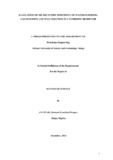| dc.description.abstract | Worldwide awareness of thin-bedded reservoirs (including turbidites) has become increasingly important with about 30-40% of the world’s oil in-place resources confined within thin-bed laminated reservoirs (Tyagi et al. 2008). The Niger delta petroleum province is characterized by turbidite formations which are a form of thin-bed laminated reservoirs. They are characterized by intercalation of sand and shale beds with the sand beds, containing a substantial amount of shale lenses. The distribution of the shale lenses results in gross heterogeneity in reservoir properties such as porosity and permeability.
With the natural reservoir energy, averagely, only 10-40% of the oil originally in place can be recovered from the reservoir. To recover more of the oil in place, additional energy must be injected into the system to enhance/improve the recovery. The common improved oil recovery (IOR) methods include water flooding and gas injection. Water Alternating Gas injection (WAG) is another applicable IOR method that combines water and gas injection in a cyclic alternating manner.
This study was conducted to evaluate the recovery efficiency of water-flood, gas-flood and WAG injection by simulation of a mature turbidite reservoir model from the Niger Delta.
In the execution of the study, the rates of injection of water and gas in the water flooding and gas-flooding, respectively, were sensitized. Sensitivity analyses of factors affecting WAG efficiency including the WAG rate, WAG ratio, WAG cycle and preferential fluid with which to begin the WAG with were conducted. The simulations were done in ECLIPSE 100.
The optimal reservoir fluid volume rate of water and gas for water- and gas-flooding respectively were obtained to be 20000 rb/day and 200000 rb/day. The optimal WAG procedure obtained was; WAG rate (15000 rb/day water, 200000 rb/day gas), WAG ratio (1:14), WAG cycle (50 days gas, 200 days water) and gas injected first. From the simulations of the optimal procedures conducted, water-flooding yielded the highest oil recovery of 55.56% followed by gas-flood with a recovery factor (RF) of 54.16% and then WAG came last with RF = 52.83%.
Economic analysis conducted on the three IOR methods showed that water-flooding is the most profitable with an additional profit between MM$ 530.33 to MM $ 1,810.90 in a 90% confidence interval. It is therefore, the recommended IOR method to be implemented. | en_US |

